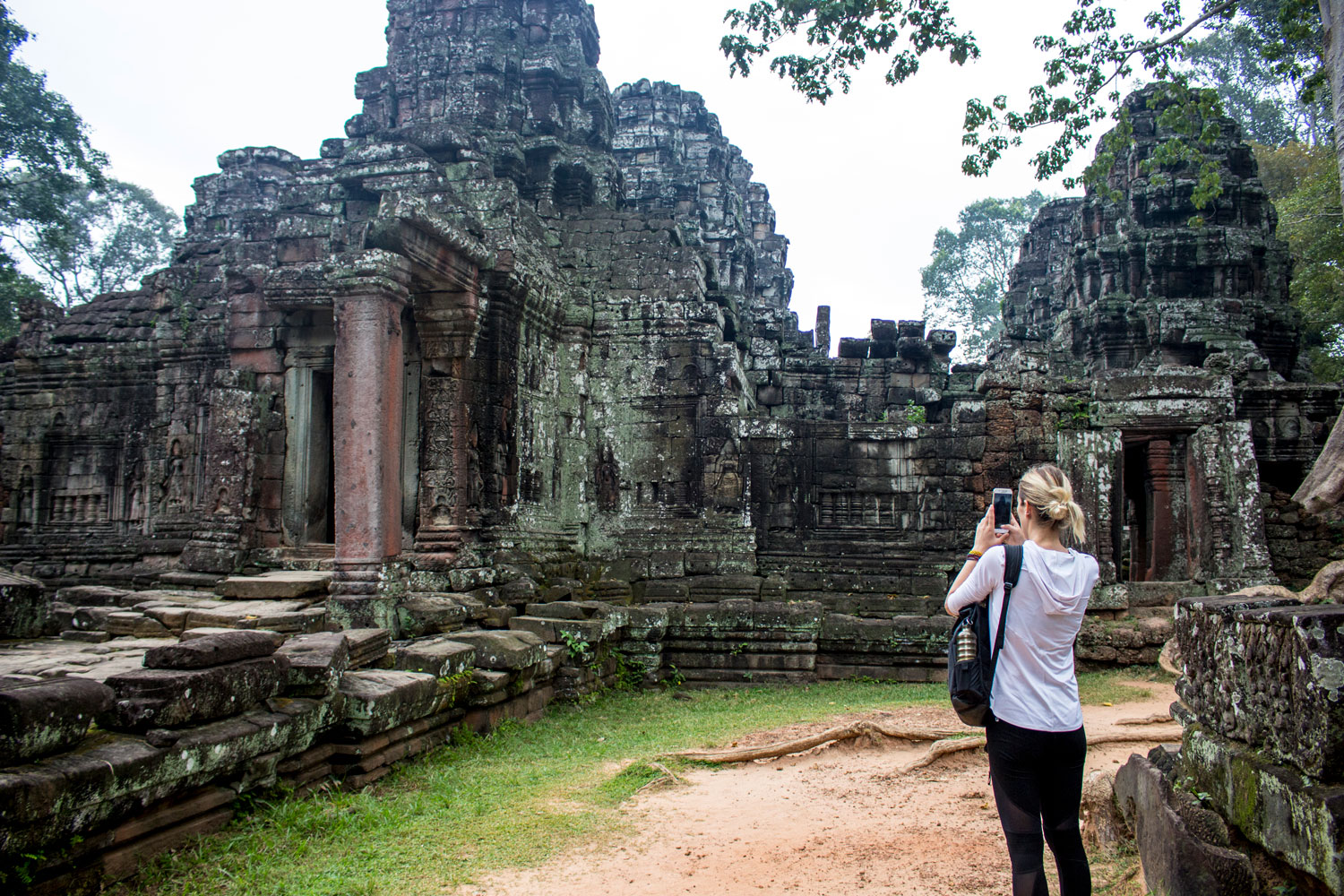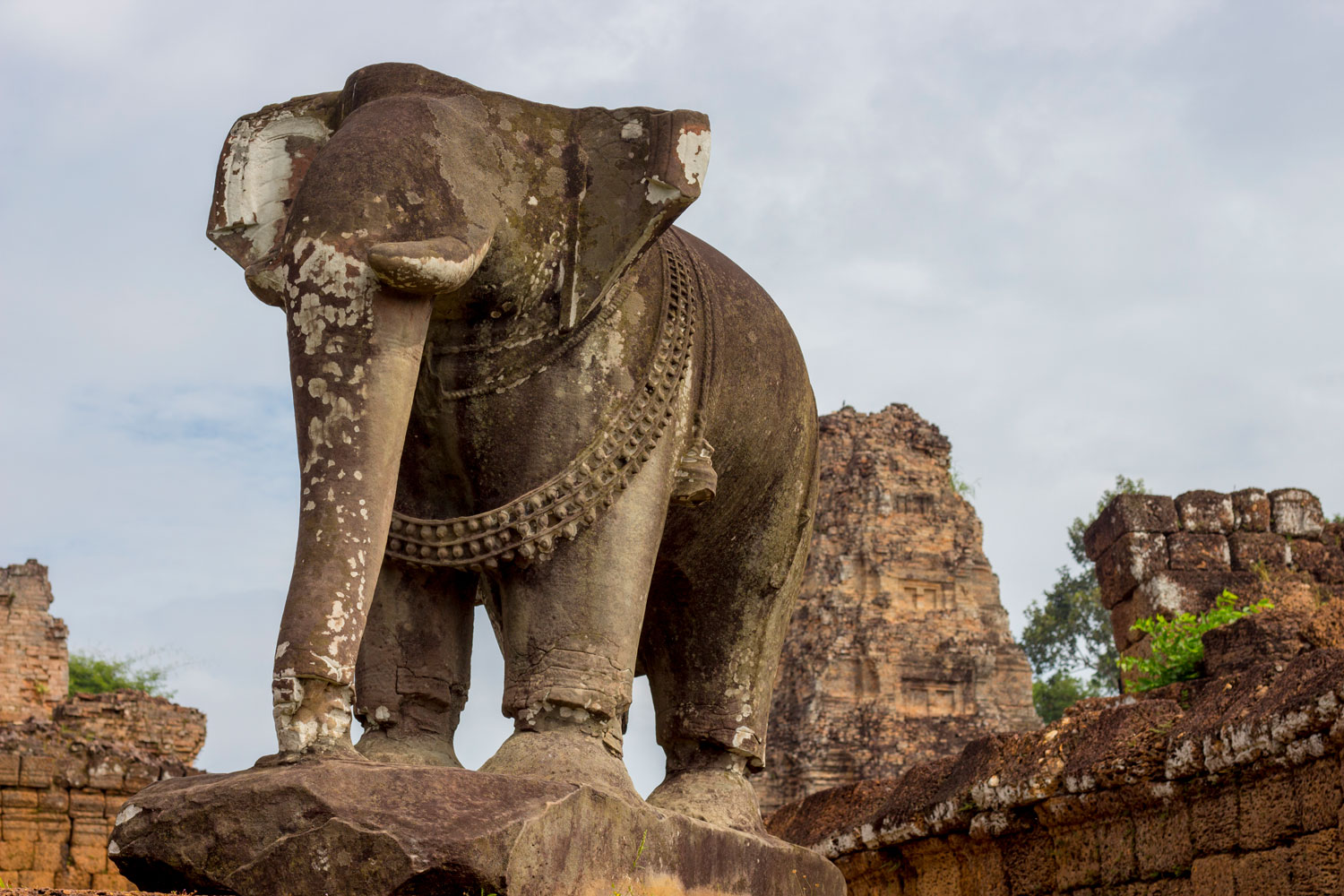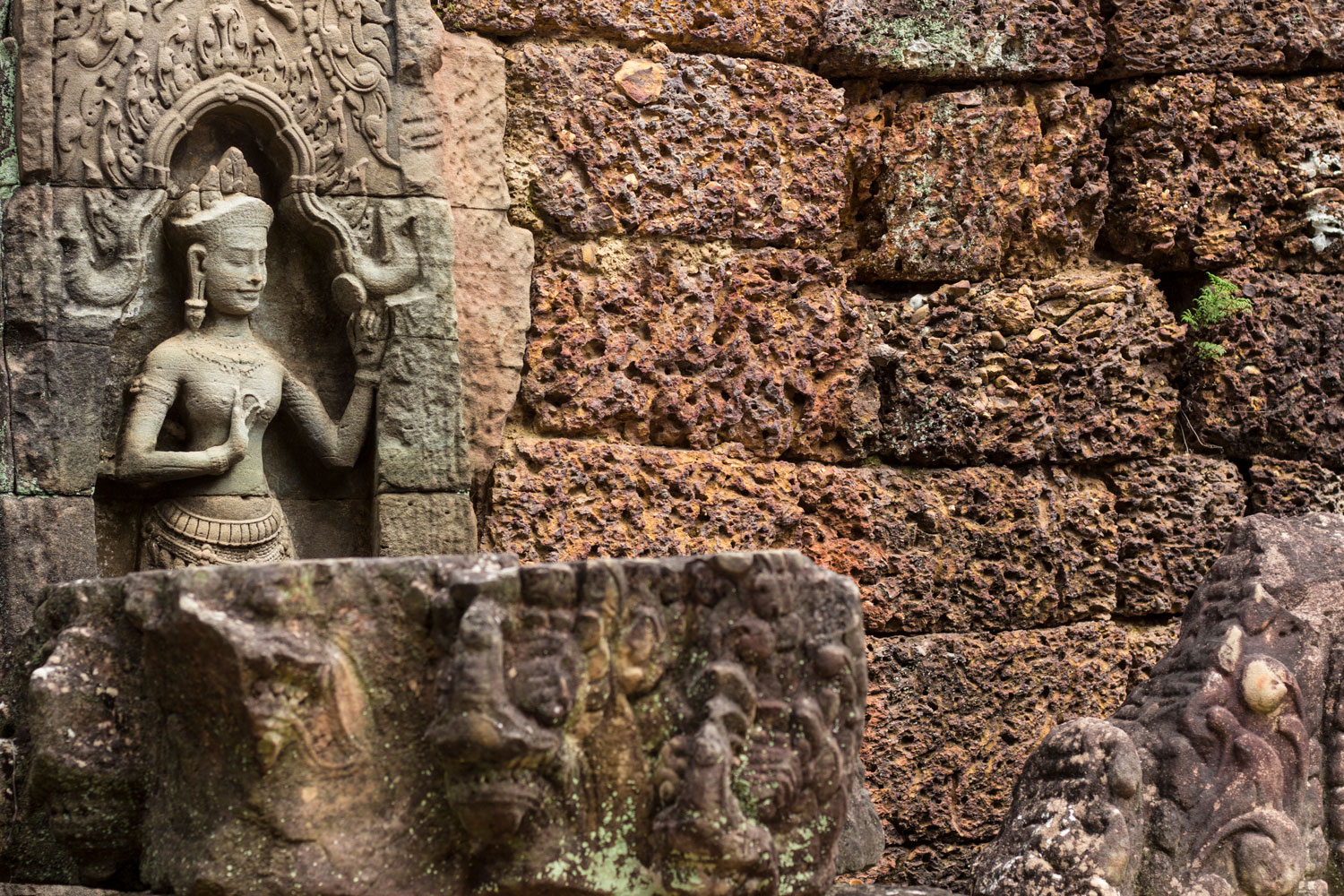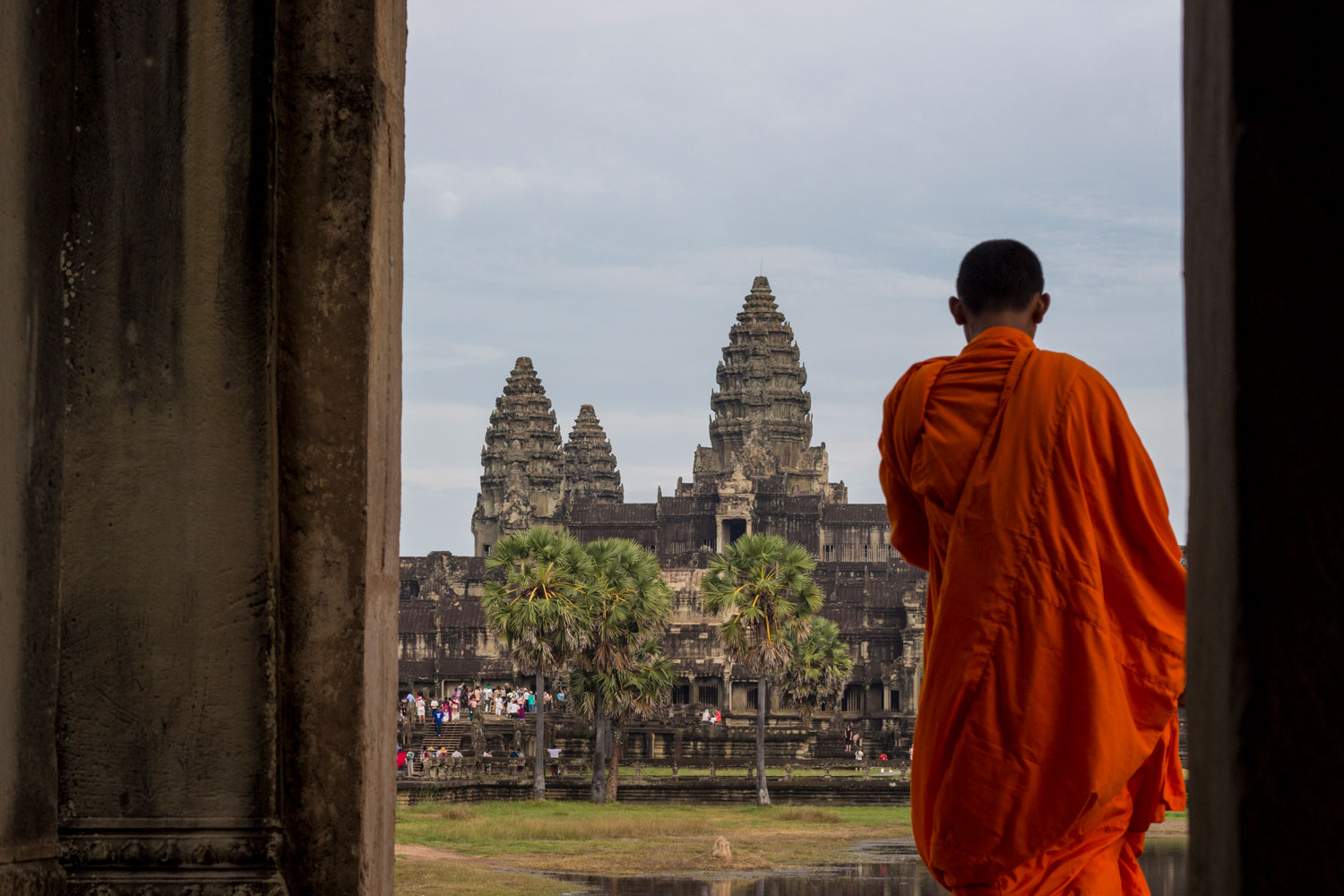Angkor, Cambodia: Avoiding crowds + must see temples
A little slip up brought us to Cambodia. We’d been so wrapped up in the beauty and ease of Taiwan and Malaysia that we plum forgot to check Vietnam’s visa requirements. Surprise, Canadians need one! It was an hour and a half before our flight to Hanoi when we came to realize the plane would most definitely be leaving without the two of us onboard. Since we had little intentions of heading back into KL, we took the opportunity to live out one of Ryan’s dreams: show up at the airport and hop on whatever flight is leaving next. And so, one little hour later, we were miles high headed to Cambodia.
(As for that visa, we would eventually get one. We used VietnamVisaPro.com and it couldn’t have been easier.)
The entrance to Preah Khan is a beautiful reminder of the power of nature.
Avoiding the crowds in the Temples of Angkor
It goes without saying, but we’re going to say it anyway: if you’re in Siem Reap, you must visit Angkor. The massive ancient complex, once home to over 1 million people, sprawls across some 400 square km with what’s said to be over a thousand temples in varying states of preservation.
Now a UNESCO World Heritage Site, Angkor is one of Southeast Asia’s most important archaeological sites with Angkor Wat topping the list for most travellers to the area. It’s impressive, you’ll hear no argument from us here, but what we found were a number of other awe-inspiring monuments that deserve your attention. From the quiet solitude of Srah Srang as the sun rises, to the ethereal entrance to Neak Pean amidst a lake of trees, breaking the tourist trail and setting out to see the temples on your own terms will send you home with a much more memorable experience.
The most important thing to understand is that if you only have 1 day, your hostel will sell you one of two tours – Small and Big Circuit – but you’ll likely find your dollars better spent planning out a route all your own. These tours, efficient as they may be, will have you following hoards of other tourists all day and missing some of the most wonderful sights.
Instead, we found luck in drafting our wish list and negotiating with a tuktuk driver to make it happen. What we found follows - dive into the 360° video of our day and read on for itenrary and photos.
Angkor Sightseeing Tip #1: Get a Great TukTuk Driver
Successfully beating the crowds requires finding a nice tuktuk driver who won’t renegotiate the rate part way through. Consider taking a few rides around town to see if you come across a great driver. Maybe even find one outside of the tourist district, which, as a general rule, will almost always benefit you. Many drivers are very kind and eager to show you the sights, but just as many are out to make a (USD) buck – so do your research and follow your gut. We had a lovely fellow outside the hostel who listened to our plan, offered a fair rate ($30 USD, 5am-5pm) and we couldn’t have been happier.
With a one-day pass, a 3-in-1 coffee breakfast and a friendly driver at the helm, we set out to see the temples without the crowds.
Angkor Sightseeing Tip #2: Do Things Backwards
Sunrise tours generally kick off at Temple Wat for, admittedly, a beautiful view. However, the aforementioned circuits mean the crowd moves with you from them on.
Start instead at Srah Srang to watch the sun rise over the glorious lake, with nary a soul in sight. Dip your feet into the warm waters and be whisked centuries back in time. As the sun moves through the sky, move on to bigger and bigger temples until you wrap up the day at Angkor Wat. It’s hard to find yourself with temple fatigue when each one is more impressive than the last.
Must See Temples of Angkor
In the end, we hustled and were able to visit 11 temples in 12 hours, including a stop for lunch (bring your own, lest you enjoy being truly gauged). Here is our route along with a few recos on temples to skip for a slightly slower pace:
- Srah Srang: arrive for sunrise, you’ll likely find no one else there
- Pre Rup: let your driver nap, walk over to spend the time until other temples open
- Banteay Kdei: pop in for a quick visit, meet your driver at 8am to head onward
- Ta Prohm: the legendary Lara Croft temple, start getting a sense of the grandeur
- Eastern Mebon: a quick visit, similar to Pre Roup and could be skipped
- Ta Som: ditto here, similar to Banteay Kdei and could be skipped for a slower day
- Neak Pean: a must see, the watery entrance is unreal and pictures will not do it justice
- Preah Khan: our favourite, jungle like Ta Prom with fewer crowds and active restoration
- Bayon: things start to get big here and the many faces are a wonderful sight up close
- Baphuon: scurry up to the top (#legday) for a beautiful view if you have time to spare
- Angkor Wat: the big one, make sure to leave at least 2 hours and head to the top early
Srah Srang
Srah Srang's majestic landing stage adorns the west end of the massive lake, dug in the mid 10th century, offering a remarkable view of the sun rising over this once royal bath.
Pre Rup
A Hindu temple, Pre Rup is thought to have been part of the funerary process – it’s name translates to “turning the body,” harkening to the tradition of tracing a corpse’s outline with cinders.
Ta Prohm
Mighty as the temples may be, Ta Prohm is a reminder that nature inevitably wins over time. The jungle has all but swallowed this masterpiece, with massive trees growing through the temple walls.
Banteay Kdei
Just west of Srah Srang, this Buddhist monastery may not have held up the test of time – it wasn’t even fully completed – but offers lovely bas-relief and sculptures for those willing to explore its ruins.
Eastern Mebon
Guarded by stone elephant statues, the 10th century Eastern Mebon temple once sat upon a man-made island, surrounded by the water of the East Baray Reservoir which has long since dried up.
Ta Som
Built in the late 12th century, Ta Som is more of a mystery than others in the Angkor complex, although many believe the Buddhist temple was dedicated to King Jayavarman VII’s father.
Neak Pean
Four small ponds surround the waters of Jayatataka Baray, within which an artificial island houses Neak Pean. The greater lake surrounding all of this offers an otherworldly entrance where trees sprout from the water.
Preah Khan
Fusion at its finest, Preah Khan highlights carvings from both Buddhism and Hinduism in a temple where nature has equally fused itself into the architecture. Maintained, but hardly restored, it’s truly special.
Bayon
More than 200 stone faces smile upon visitors to Bayon, the impressive gateway to Angkor Thom, which marked the shift from Hinduism to the Mahayana Buddhism practiced by King Jayavarman VII.
Baphuon
A 200-meter elevated walkway leads to Baphuon, the temple whose modern history is as interesting as its past due to the 51 years spent in restoration, interrupted by the brutal Khmer Rouge regime
Angkor Wat
Incredibly well preserved and untouched by the jungle, Angkor Wat – said to be largest religious monument in the world – is as celebrated for its grandeur as its detail. Astonishing bas-relief is seen throughout the temple, which reached 213 feet into the sky at its highest













